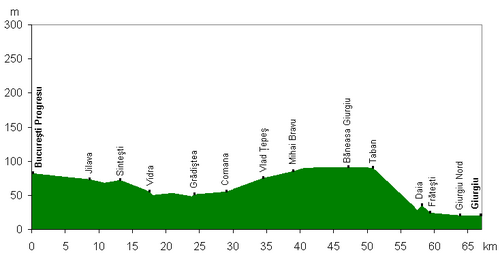Railway line București – Giurgiu Nord – Giurgiu
| Bucureşti – Giurgiu North – Giurgiu | |||||||||||||||||||||||||||||||||||||||||||||||||||||||||||||||||||||||||||||||||||||||||||||||||||||||||||||||||||||||||||||
|---|---|---|---|---|---|---|---|---|---|---|---|---|---|---|---|---|---|---|---|---|---|---|---|---|---|---|---|---|---|---|---|---|---|---|---|---|---|---|---|---|---|---|---|---|---|---|---|---|---|---|---|---|---|---|---|---|---|---|---|---|---|---|---|---|---|---|---|---|---|---|---|---|---|---|---|---|---|---|---|---|---|---|---|---|---|---|---|---|---|---|---|---|---|---|---|---|---|---|---|---|---|---|---|---|---|---|---|---|---|---|---|---|---|---|---|---|---|---|---|---|---|---|---|---|---|
| Course book route (CFR) : | 902 | ||||||||||||||||||||||||||||||||||||||||||||||||||||||||||||||||||||||||||||||||||||||||||||||||||||||||||||||||||||||||||||
| Route length: | 67 km | ||||||||||||||||||||||||||||||||||||||||||||||||||||||||||||||||||||||||||||||||||||||||||||||||||||||||||||||||||||||||||||
| Gauge : | 1435 mm ( standard gauge ) | ||||||||||||||||||||||||||||||||||||||||||||||||||||||||||||||||||||||||||||||||||||||||||||||||||||||||||||||||||||||||||||
|
|||||||||||||||||||||||||||||||||||||||||||||||||||||||||||||||||||||||||||||||||||||||||||||||||||||||||||||||||||||||||||||
The București – Giurgiu Nord – Giurgiu railway is a main line in Romania . It runs south from the capital Bucharest to the city of Giurgiu , located on the Danube and thus on the border with Bulgaria .
history
In 1866 the Romanian government signed a contract with the English company "John Trevor Barclay & John Staniforth" for the construction of the line from the capital Bucharest to the Danube port in Giurgiu. The railway line went into operation on September 7, 1869 as the first within the then borders of Romania. In Bucharest, the line began at Filaret station , making it the oldest in the Romanian capital. Initially, the connection was primarily important for freight traffic because it enabled the transport of food products from the interior of the country to the Danube and thus further to the Black Sea . On the other hand, it served to supply the Romanian capital with imported finished products. The Romanian Prince Charles I advocated the construction of a bridge over the Danube as soon as possible, in order to create a connection to Constantinople via what is now the Bulgarian city of Ruse ; At that time Romania was still under the sovereignty of the Ottoman Empire . However, since they had little interest in the project, the planning begun in 1870 was soon abandoned. The reorganization of Southeast Europe that took place at the Berlin Congress in 1878 made the project obsolete for a long time.
After the Second World War , the Romanian and Bulgarian governments resumed planning for a Danube bridge between Giurgiu and Ruse. With Soviet help, construction began in 1952 and was completed on June 20, 1954. Since then, continuous rail traffic from Romania to Bulgaria has been possible via the Giurgiu-Russe Friendship Bridge .
In 1960 the Filaret train station was closed and converted into a bus station. Since then, local trains to Giurgiu began in the Progresu suburban train station , and long-distance trains in the northern train station .
Todays situation
The route is not electrified.
In August 2005, the bridge over the Argeș collapsed during a flood near Grădiştea ; since then the route has been interrupted. Until December 2010, the section from Grădiștea to Giurgiu was served, long-distance trains between Bucharest via Giurgiu Nord to Ruse in Bulgaria via Videle . The line from Grădiştea to Giurgiu has also been out of service since the end of 2010. The construction of the new bridge has not yet started due to financial problems (as of February 2011).
After 15 years, the Viennese construction company Porr is scheduled to start rebuilding the destroyed railway bridge for around 105 million .
swell
- ^ Maria Mureșan: Appreciations regarding external capital in Romanian economy in the second half of the 19th century and in the first two decades of the 20th century . Yearbook of the University of Ștefan cel Mare in Suceava. Edition 8/2008. Suceava
- ↑ a b Lothar Maier: Romania on the way to the declaration of independence 1866–1877: appearance and reality of a liberal constitution and state sovereignty . Oldenbourg Wissenschaftsverlag, 1989. pp. 183-186
- ^ Institute for Regional Geography Leipzig: Contributions to regional geography, issues 36-39 . Institute for Regional Geography Leipzig, 1994. p. 189
- ^ Iván T. Berend : History derailed: Central and Eastern Europe in the long nineteenth century . University of California Press 2003. p. 154. ISBN 978-0-520-23299-0
- ^ NN Constantinescu: Istoria economică a României: 1939-1989 . Editura economică, 2000, p. 215.
- ^ Sebastian Bonifaciu, Emanuel Valeriu: Bucureștii de la A la Z: ghid . Meridiane, 1969. p. 28.
- ↑ Podul de la Gradistea - pozitia oficiala a CNCF CFR SA , at opiniagiurgiu.ro, accessed on July 20, 2020 (Romanian).
- ↑ Picture of the railway bridge destroyed in 2005
- ↑ Porr Construct, the only bidder in the tender for the Grădiștea bridge , on April 28, 2020 at clubferoviar.ro, accessed on July 20, 2020 (Romanian).


